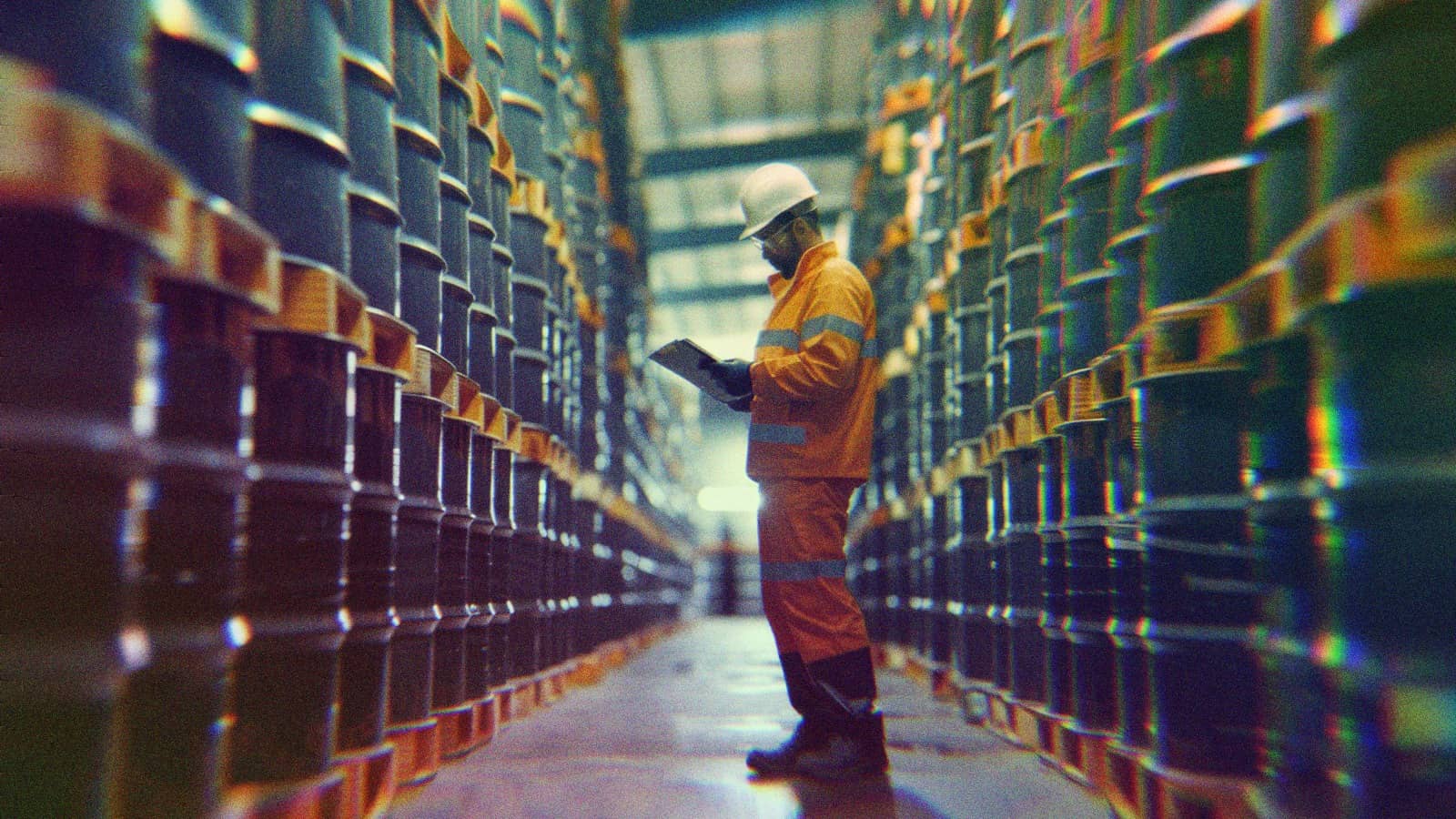The Energy Independence Myth.
 Image Description: A man standing in a warehouse filled with oil drums.
Image Description: A man standing in a warehouse filled with oil drums.
12.9 million barrels of oil per day. That’s how much crude oil the United States technically consumes. 12.9 million barrels each and every day. I say technically because crude oil consumption estimates are just that. Estimates. And I’ll explain why in a moment.
On the other side of the ledger we have production. The United States currently produces around 13 million barrels of oil per day.
Parity, right?
Now, get this…
We import about eight and a half million barrels of oil each day.
Wait. What?
That’s right. The United States produces enough crude oil to supply the entire nation so we theoretically don’t have to look outside of the U.S. for oil. On paper that is. In reality, oil is a lot murkier than that. Pun intended.
Crude Definitions
Let’s begin with some fun facts.
- More than 18,000 miles of abandoned oil pipes lay on the ocean floor in the Gulf of Mexico.
- There are more dormant oil wells in the Gulf than there are productive ones, about 14,000 in fact.
- To cap the ones in federal waters with concrete would cost somewhere in the neighborhood of $30 billion dollars. That’s what is supposed to happen when a rig and its wells are decommissioned. Instead, the two agencies with regulatory and enforcement oversight, The Bureau of Ocean Energy Management and Bureau of Safety and Environmental Enforcement have simply looked the other way.
That’s a sampling of the waste associated with crude oil production in just one part of the United States.
In terms of active capacity, according to Baker Hughes—a company that has tracked oil and gas rig activity since 1944—there are about 585 active oil rigs throughout the United States, most of which are on land. There’s somewhere around 18 to 20 active offshore rigs, each of which can manage up to 80 wells at a time, and most of these are in the Gulf of Mexico dotted amongst the aforementioned abandoned rigs.
This is just oil we’re talking about. We’re not even touching on gas or renewable energy sources. Just pure crude oil.
This infrastructure alone allows the United States to pump 22% of the world’s supply of crude oil. The next largest producer is Saudi Arabia at 11%. People might find this surprising since we paint nations such as Iran, Saudi Arabia and Venezuela as petrostates. But in terms of sheer production, we’re double the next largest oil producing country.
So we have hundreds of rigs on land, a bunch in the ocean, abandoned pipelines strewn about the ocean floor, dormant rigs on top of wells that could have huge methane blowouts at any time, and no regulator holding them accountable. If our country was a person they would be bathing in crude, brushing their teeth with it and pouring it down the sink.
And yet we’re still bringing in eight and a half million barrels every day from other countries, which pumps air into the windbag politicians who claim we’re dependent on foreign oil.
To unpack this, consider a few factors.
One. If we doubled the amount of oil we pulled from the ground we would still bring it in from other countries because we can’t afford to—and shouldn’t—expand our infrastructure.
Two. The type of crude we produce isn’t ideally suited for the various uses for it.
Three. domestic production doesn’t exactly correlate to crude oil prices on the market exchanges because it’s a globally priced commodity. We’re just a piece of it. Other oil producing nations can increase or decrease production and reserves to impact exchange prices so it’s not all about us.
The third point is self-explanatory so let’s address the others and talk about infrastructure. Here’s how the logistics work:
The crude oil infrastructure is generally located near the areas in which it’s extracted. Makes sense. Refineries, storage facilities and transportation hubs are centralized in these areas. If we wanted to evenly distribute oil throughout the country to reduce our dependence on foreign sources, we would build a hub and spoke network of pipelines across the country like a spider web and have thousands of refineries. That means that every region, every city and every town would have refineries and storage facilities. Nobody wants that.
Instead, we complement our pipelines with oil tankers and train cars to move certain distillates throughout the country. On the coasts, we bring it in through the ports from other destinations so that we don’t have to build refineries and pipelines in your backyard.
Regarding our second point about types of crude, some of the distillates we bring in from foreign sources are more suited to the end production goal they’re being used for. Some oil is refined to standards meant for engines. Others are used for home heating oil or producing plastics. I know the extraction and combustion of this stuff is killing the planet but the science behind is pretty fascinating. Learning about distillates is like studying to become a sommelier.
Sir, would you care to see our oil menu?
Yes, please. Any recommendations?
Of course I can make several pairing recommendations with our tasting menu this evening. From our friends in the north we have an excellent West Canadian Select, a complex oil with a high sulfur content and just a hint of bitumen. Pairs excellent with the oil slick pigeon, which is prepared medium rare with shavings of tractor tires.
Hmmm. I had oil slick pigeon just last week.
Of course. Staying in the high sulfur content we also have a ‘24 Murban from Dubai. It’s a light sour crude with a high fuel oil content that goes well with the plastic filled tuna the chef has adorned with Dorito bags and cigarette butts from the plastic island in the Pacific.
Tempting. Anything on the lighter side?
But of course. We have a limited selection of Bonny Light from Nigeria, a sweet, high middle distillate that perfectly complements the rigatoni ala petroleum, served on an expended lithium battery with a hint of methane and trace of formaldehyde.
Mmmmm. I think we have a winner.
False Narratives
To hear Republicans tell the story, the country still needs to “drill baby drill” and the Biden administration has hobbled the industry, making us vulnerable to mysterious foreign adversaries. Yet under the Biden administration, the top five U.S. oil and gas companies have pulled in more than $250 billion in profits between 2021 and 2023. Rather than focusing on this as a bad thing preventing serious investments into a renewable future, the Democrats are running this fact produly and taking credit for expanding the number of leases and the historic rate of U.S. production.
The Biden/Harris administration has routinely touted the fact that there are 9,000 open licenses on federal land that oil and gas companies have yet to utilize. This is absolutely true. There’s nothing the government is doing right now to impede the extraction or production of oil and gas from land in the continental United States or immediately offshore. Technological breakthroughs in horizontal drilling and detection of proven reserves has made the current operations vastly more efficient than they used to be, thereby making it inefficient and costly to start up a new operation. There simply isn’t any need to do so.
And yet, the narrative persists that we’re still reliant on foreign oil, which makes us somehow vulnerable to bad actors. But 95% of the oil we import comes from staunch allies of the United States that could hardly be characterized as bad actors: Canada is responsible for 50% of the imports, with Mexico, Brazil and Iraq making up the balance. Only 5% comes from what a normal person would consider a bad actor on the world stage: Saudi Arabia. Last time I checked, they’re still an ally so this narrative is completely false.
When Russia invaded Ukraine the Biden administration sanctioned the import of Russian oil and it shut off like a spigot overnight. And nothing happened because we have plenty of options. During the supply chain crisis we started importing a limited amount of oil from Venezuela again, but we can shut that off in an instant as well.
So the short answer here is that we are, in fact, very much energy independent. We choose to be a net exporter of oil—meaning we don’t use 100% of what we produce—because it makes practical and economic sense to do so. We sell the stuff that others need and bring in what suits our needs from our closest allie,s because it would be lunacy to build a pipeline and refinery in every neighborhood in America.
The Bigger Economic Cost
Of course, there’s another massive cost borne by the inhabitants of the planet that registers on the federal balance sheet, but not the income statements of the oil and gas companies themselves.
The IMF estimates that the harmful effects of pollution from fossil fuel production costs the United States around $646 billion every single year. They arrive at this by adding up the real costs of wildfires, droughts and premature deaths from heat and pollution.
In very direct and traceable terms, the U.S. government still hands the oil and gas industry somewhere in the neighborhood of $20 billion in subsidies each year as well. Put another way, holding back 18 months worth of subsidies could cover the cost to cap all of those abandoned wells waiting to blow methane and pollute the Gulf of Mexico. Put yet another way, a quarter of oil and gas profits are directly tied to handouts from the U.S. government.
Energy independence from other countries isn’t the goal. Reducing our dependence upon fossil fuel energy sources is the goal. It’s rather unbelievable that the Democratic Party feeds into the energy independence narrative by boasting about open leases and standing behind the oil and gas industry. It’s not that complicated but both parties treat us like we’re idiots.
Let’s roll play a debate between a typical Republican and a (clearly) fake Democrat that we could only wish was real.
Moderator: Welcome back to the Decision 2024 debate. Our next topic is energy. We’ll start with the Republican candidate. Here’s the question. As president, what would your energy policy be?
Typical Republican Candidate: “The Biden administration has made us vulnerable by attacking our own oil industry under the Green New Deal. If elected, I promise to invest in our oil and gas companies and clear the way to expand drilling throughout the United States to create more good paying jobs and make us energy independent. Make America great again.”
(Flicks cowboy hat, spits on the ground, and kicks a puppy.)
Moderator: Imaginary Democratic candidate, your response.
Imaginary Democratic Candidate: “We’re already energy independent. You have no idea what you’re talking about so stop treating the American people like they’re stupid. One: Renewable energy jobs are the fastest growing jobs in America. Fact. Look it up.
Two: American oil and gas companies don’t need investments from the United States. They already receive $20 billion in subsidies each year and the top five fossil fuel companies posted $250 billion in profits between 2021 and 2023.
Three: There are 9,000 unused oil leases on federal lands already because the oil companies said they don’t need them.
Four: We already produce more oil than we use. We bring oil in from our closest allies because it’s more cost effective to do it that way. The alternative would be to build a pipeline through every neighborhood in the country and a refinery in every town.
And, Five: The Green New Deal doesn’t exist. But it should. And I’m happy to talk about that if you’d like because we’re killing the planet, reducing life expectancies and subsidizing the wrong industries.”
(Walks cooly over to Typical Republican, knocks off cowboy hat, gives peace sign to camera and drives off in a Subaru.)
Imagine having a candidate that told the truth like this; one that didn’t treat us like morons and could dismantle these fraudulent talking points? Oh, that’s right. We did.
Here endeth the lesson.
Max is a political commentator and essayist who focuses on the intersection of American socioeconomic theory and politics in the modern era. He is the publisher of UNFTR Media and host of the popular Unf*cking the Republic® podcast and YouTube channel. Prior to founding UNFTR, Max spent fifteen years as a publisher and columnist in the alternative newsweekly industry and a decade in terrestrial radio. Max is also a regular contributor to the MeidasTouch Network where he covers the U.S. economy.


